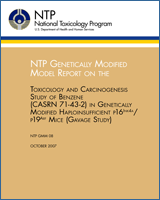This is a work of the US government and distributed under the terms of the Public Domain
NCBI Bookshelf. A service of the National Library of Medicine, National Institutes of Health.
Dunnick JK, Malarkey DE, Bristol DW, et al. NTP Genetically Modified Model Report on the Toxicology and Carcinogenesis Study of Benzene (CASRN 71-43-2) in Genetically Modified Haploinsufficient p16Ink4a/p19Arf Mice (Gavage Study): NTP GMM 08 [Internet]. Research Triangle Park (NC): National Toxicology Program; 2007 Oct.

NTP Genetically Modified Model Report on the Toxicology and Carcinogenesis Study of Benzene (CASRN 71-43-2) in Genetically Modified Haploinsufficient p16Ink4a/p19Arf Mice (Gavage Study): NTP GMM 08 [Internet].
Show detailsOn August 28, 2006, the draft Report on the toxicology and carcinogenesis study of benzene received public review by the National Toxicology Program’s Board of Scientific Counselors’ Technical Report Subcommittee. The review meeting was held at the National Institute of Environmental Health Sciences (NIEHS), Research Triangle Park, NC.
Dr. J.K. Dunnick, NIEHS, introduced the study of benzene in haploinsufficient p16Ink4a/p19Arf mice by reviewing the derivation of the mouse strain and describing the uses and previous carcinogenicity studies of benzene, the dose selection and protocol for the present study, and the nonneoplastic and neoplastic lesions, hematologic changes, and micronucleus formation observed in the 27-week study. The proposed conclusions were clear evidence of carcinogenic activity of benzene in male haploinsufficient p16Ink4a/p19Arf mice and no evidence of carcinogenic activity of benzene in female haploinsufficient p16Ink4a/p19Arf mice.
Dr. Soper, the first principal reviewer, felt the study was well conducted and gave a definite response. He noted that the top dose may have equaled the maximum tolerated dose and suggested that reducing the number of dose groups but increasing the number of animals per group might increase the study sensitivity.
Dr. Walker, the second principal reviewer, agreed with the proposed conclusions. He suggested more discussion of the possible role of genotoxicity in benzene carcinogenesis and noted some unpublished dissertation research indicating that benzene could induce point mutations.
Dr. Birt, the third principal reviewer, also agreed with the proposed conclusions and had no major scientific criticisms.
Dr. J.R. Bucher, NIEHS, noted that in a previous study involving this model and with no neoplastic response, a statement had been added to the conclusion indicating that the sensitivity of the model was still uncertain. Dr. Deininger said that in the present benzene study, where there was a clear neoplastic response, such a qualifier might not be needed.
Dr. Soper moved, and Dr. Mirsalis seconded, that the conclusions be accepted as written. The motion was approved unanimously with seven votes.
- SUMMARY OF TECHNICAL REPORTS REVIEW SUBCOMMITTEE COMMENTS - NTP Genetically Modi...SUMMARY OF TECHNICAL REPORTS REVIEW SUBCOMMITTEE COMMENTS - NTP Genetically Modified Model Report on the Toxicology and Carcinogenesis Study of Benzene (CASRN 71-43-2) in Genetically Modified Haploinsufficient p16Ink4a/p19Arf Mice (Gavage Study)
- protein phosphatase Slingshot homolog 1 isoform X7 [Homo sapiens]protein phosphatase Slingshot homolog 1 isoform X7 [Homo sapiens]gi|2462532529|ref|XP_054228300.1|Protein
- GNAS isoform X6 [Rattus norvegicus]GNAS isoform X6 [Rattus norvegicus]gi|1958759954|ref|XP_038960232.1|Protein
- PREDICTED: Rattus norvegicus GNAS complex locus (Gnas), transcript variant X12, ...PREDICTED: Rattus norvegicus GNAS complex locus (Gnas), transcript variant X12, misc_RNAgi|2678927317|ref|XR_010064565.1|Nucleotide
- yw23b01.s1 Morton Fetal Cochlea Homo sapiens cDNA clone IMAGE:253033 3', mRNA se...yw23b01.s1 Morton Fetal Cochlea Homo sapiens cDNA clone IMAGE:253033 3', mRNA sequencegi|1070903|gnl|dbEST|390952|gb|H886Nucleotide
Your browsing activity is empty.
Activity recording is turned off.
See more...